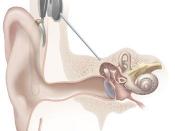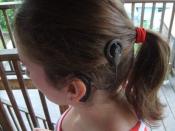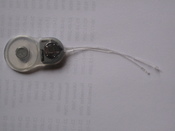Bionic Ear
The bionic ear (cochlear implant) is an artificial hearing device designed to help hearing impaired and profoundly deaf people. Parts of the bionic ear are implanted into the skull other parts are worn on the out side of the body, the internal par t is called the head set. The headset consists of a 22-channel stimulator that is held in a titanium capsule with platinum electrodes which is inserted into the shell-like structure in the inner ear known as the cochlea. A ball electrode is implanted under a muscle near the ear.
The speech processor is externally worn, it can be worn behind an ear or held in a pocket. The coil is held in position against the skin by a magnet and the microphone is worn behind the ear.
Speech and other sounds are picked up by the microphone and are sent to the speech processor.
The speech processor changes sounds into electrical signals that are sent through a cable to the transmitting coil.
The coil sends the signals through the skin to the implant which transforms the signal to electrical pulses. The pulses pass from the electrode array and stimulate hearing nerve fibres within the cochlea.
It is not possible to make the sounds heard by the bionic ear completely natural, and this is because in the implant their are only 22 electrodes that are replacing the function of thousands of hair cells in a normal hearing ear.
The materials used in the bionic ear are platinum and titanium, below is some information on the two elements.
Platinum
Symbol: Pt
Atomic Number: 78
Atomic Weight: 195.075(s)
Melting Point: 2041.4 K
Boiling Point: 4098 K
Platinum is soft, dense, ductile metal that is very resistant to corrosion. Because it is very good electricity conductor and is very...


